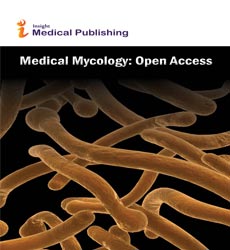Abstract
Mycobiome and interkingdom interactions
Mammalian hosts contain a diverse mycobiome. Colonization sites on the oral and genital mucosa are shared by Candida albicans, Staphylococcus aureus and herpes simplex virus (HSV-1, and HSV-2); however, their interactions are poorly understood. To test whether viral entry into cells results in the differential display of receptors shared between HSV, C. albicans and/or S. aureus, HeLa229 cells were infected with HSV-1 (KOS) gL86 or HSV-2 (KOS) 333gJ- then exposed to S. aureus (ATCC 25923) and/or C. albicans (30 min; 370 C; n=16). Adherence of C. albicans yeast cells and S. aureus to HSV-1 infected HeLa cells varied over time. The level of C. albicans adherence to HSV-1 infected cells was enhanced as compared to controls. Adherence was maximized at 90 min. (191% of control) and 180 min. 146% of control. Interestingly, between 105 and 150 minutes there was inhibition of adherence that ranged from 92% to 97% of control. In contrast, adherence of S. aureus was inhibited. The HSV-mediated inhibition occurred over the initial 120 minutes. Inhibition ranged from a low of 77% of adherence to uninfected homologous controls at 45-60 minutes to restoration of adherence to control levels at 120-165 minutes before decreasing to 92% of control at 180 minutes. Our model suggests that the HSV-1 antagonist interaction with S. aureus as well as its enhancing interaction with C. albicans is a dynamic time-dependent interaction which may correlate with rate of receptor turnover or unmasking as it correlates with the HSV-1 entry process
Author(s):
Balbina J Plotkin
Abstract | PDF
Share this

Google scholar citation report
Citations : 164
Medical Mycology: Open Access received 164 citations as per google scholar report
Abstracted/Indexed in
- Google Scholar
- China National Knowledge Infrastructure (CNKI)
- Directory of Research Journal Indexing (DRJI)
- WorldCat
- Publons
- Geneva Foundation for Medical Education and Research
- Secret Search Engine Labs
Open Access Journals
- Aquaculture & Veterinary Science
- Chemistry & Chemical Sciences
- Clinical Sciences
- Engineering
- General Science
- Genetics & Molecular Biology
- Health Care & Nursing
- Immunology & Microbiology
- Materials Science
- Mathematics & Physics
- Medical Sciences
- Neurology & Psychiatry
- Oncology & Cancer Science
- Pharmaceutical Sciences
